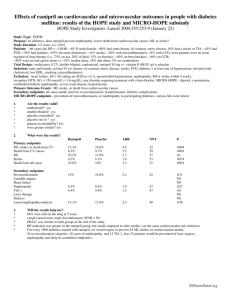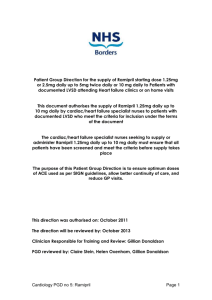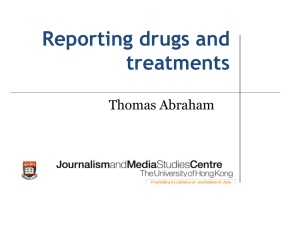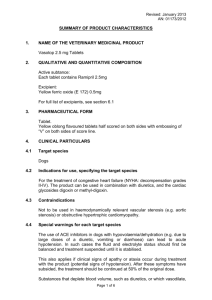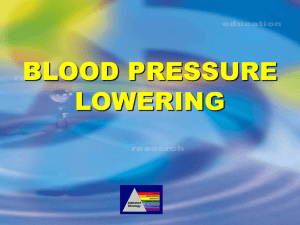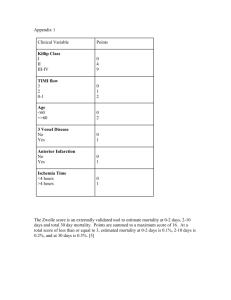HOPE - International Task Force for Prevention of Coronary Heart
advertisement
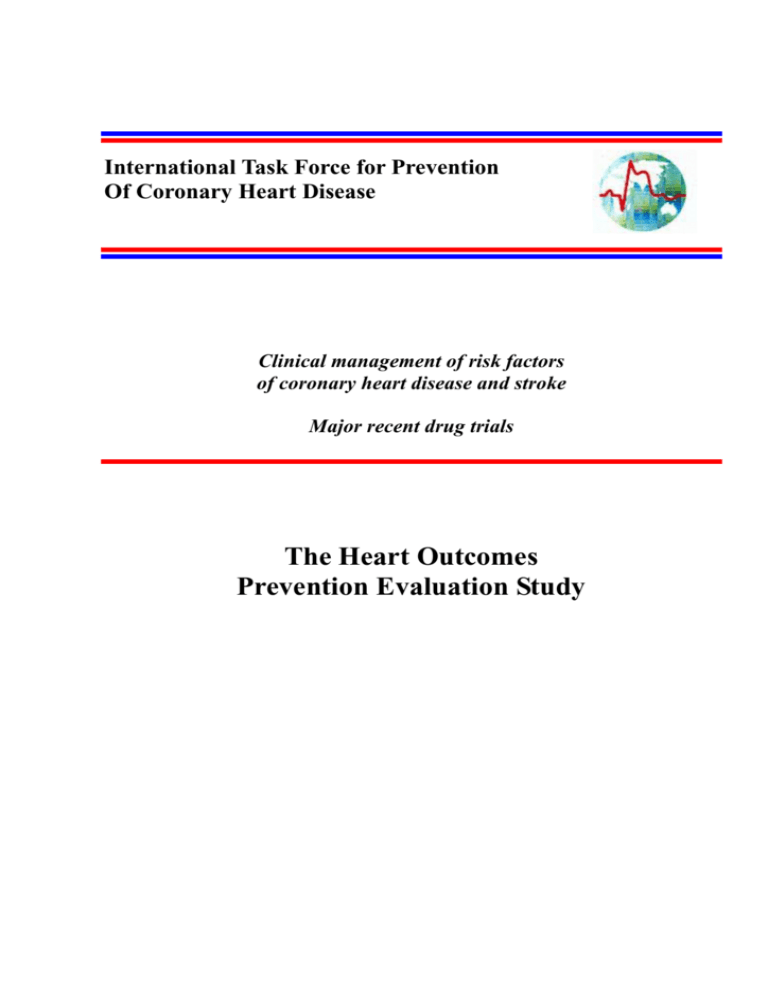
International Task Force for Prevention Of Coronary Heart Disease Clinical management of risk factors of coronary heart disease and stroke Major recent drug trials The Heart Outcomes Prevention Evaluation Study International Task Force for Prevention of Coronary Heart Disease Major recent drug trials The Heart Outcomes Prevention Evaluation Study TABLE OF CONTENT 2 Slide 1: Objective and design 3 Slide 2: Eligibility 4 Slide 3: Baseline characteristics of patients 5 Slide 4: Compliance with study medications 6 Slide 5: Blood pressure 7 Slide 6: Ramipril: Incidence of the primary outcome and of deaths from any cause 8 Slide 7: Incidence of secondary and other outcomes 9 Slide 8: Incidence of coronary events and revascularisation 10 Slide 9: Clinical outcomes in patients with diabetes: Results of the MICRO-HOPE substudy 11 Slide 10: Incidence of primary and other outcomes in women and men 12 Slide 11: Vitamin E: Incidence of the primary outcome and of deaths from any cause 13 Slide 12: Conclusions 14 International Task Force for Prevention of Coronary Heart Disease Major recent drug trials The Heart Outcomes Prevention Evaluation Study Slide 1: Objective and design The Heart Outcomes Prevention Evaluation (HOPE) Study Objective • Assessment of the effects of an angiotensin-convertingenzyme inhibitor, ramipril, and of the antioxidant vitamin E in patients at high risk for cardiovascular events but without left ventricular dysfunction or heart failure Primary Outcome • Myocardial infarction, stroke or death from cardiovascular causes Design • Two-by-two factorial, placebo-controlled, double-blind, randomised study for a mean duration of five years Source: The Heart Outcomes Prevention Evaluation Study Investigators, N Engl J Med 2000;342:145-153 Objective and design This slide shows the objective and design of the Heart Outcomes Prevention Evaluation (HOPE) study. Epidemiological and experimental data suggest that blocking the activation of the renin-agiotensin-aldosterone system by an angiotensin-convertingenzyme inhibitor may have an important role in reducing the risk of cardiovascular events. Observational studies have indicated that a high intake of vitamin E may result in lower rates of coronary events and lower rates of progression of coronary artery lesions. This study is designed to evaluate the effects of both medications independently on cardiovascular and other outcomes. Patients were randomly assigned to receive ramipril (up to10 mg/day), vitamin E (400 IU/d), their combination, or matching placebos. 3 International Task Force for Prevention of Coronary Heart Disease Major recent drug trials The Heart Outcomes Prevention Evaluation Study Slide 2: Eligibility ELIGIBILITY • Men and women • Age ≥ 55 years • History of coronary artery disease, stroke, peripheral vascular disease or diabetes plus at least one other cardiovascular risk factor Source: The Heart Outcomes Prevention Evaluation Study Investigators, N Engl J Med 2000;342:145-153 Eligibility This slide shows the eligibility criteria for the participants of the HOPE study. Other cardiovascular risk factors included hypertension, elevated total cholesterol levels, low high-density lipoprotein cholesterol levels, cigarette smoking, or documented microalbuminuria. 4 International Task Force for Prevention of Coronary Heart Disease Major recent drug trials The Heart Outcomes Prevention Evaluation Study Slide 3: Baseline characteristics of patients Baseline Characteristics of Patients Characteristic Age (y) Blood pressure (mm Hg) Heart rate (beats/min) BMI (kg/m2) Female sex (%) History of coronary artery disease (%) Stroke or transient ischemic attacks (%) Peripheral vascular disease (%) Hypertension (%) Diabetes (%) Documented elevated total cholesterol level (%) Documented low HDL-cholesterol level (%) Current cigarette smoking (%) Microalbuminuria (%) Ramipril (n=4645) Placebo (n=4652) 66 139/79 69 28 27.5 79.5 10.8 42.3 47.6 38.9 65.4 18.1 13.9 20.5 66 139/79 69 28 25.8 81.4 11.0 44.8 46.1 38.0 66.4 18.9 14.5 21.6 Source: The Heart Outcomes Prevention Evaluation Study Investigators, N Engl J Med 2000;342:145-153 Baseline characteristics of patients This slide shows baseline characteristics of the HOPE-participants. Patients were recruited from December 1993 to June 1995 at 129 centres in Canada, 27 centres in the United States, 76 centres in 14 western European countries, 30 centres in Argentina and Brazil, and 5 centres in Mexico. Of the total of 9541 patients, 4645 were randomly assigned to ramipril (10mg/d), 4652 to placebo and 244 to a low dose of ramipril (2.5 mg/d). In addition, all patients were randomly assigned to receive 400 IU of vitamin E per day or matching placebo. 5 International Task Force for Prevention of Coronary Heart Disease Major recent drug trials The Heart Outcomes Prevention Evaluation Study Slide 4: Compliance with study medications Compliance with Study Medications Compliance (%) 100 compliance with ramipril or an open-label angiotensinconverting-enzyme inhibitor 90 80 vitamin E 70 = 1 2 3 4 5 years Source: The Heart Outcomes Prevention Evaluation Study Investigators, N Engl J Med 2000;342:145-153 & The Heart Outcomes Prevention Evaluation Study Investigators, N Engl J Med 2000;342:154-160 Compliance with study medications This slide shows the compliance with the study medications vitamin E and the combined compliance of ramipril or an open-label angiotensin-converting-enzyme inhibitor. 6 International Task Force for Prevention of Coronary Heart Disease Major recent drug trials The Heart Outcomes Prevention Evaluation Study Slide 5: Blood pressure Blood Pressure Ramipril Placebo Baseline mean blood pressure 139/79 139/79 at one month 133/76 137/78 at two month 135/76 138/78 at end of study 136/76 139/77 Source: The Heart Outcomes Prevention Evaluation Study Investigators, N Engl J Med 2000;342:145-153 Blood pressure This slide shows mean blood pressure values at different points during study followup. 7 International Task Force for Prevention of Coronary Heart Disease Major recent drug trials The Heart Outcomes Prevention Evaluation Study Slide 6: Ramipril: Incidence of the primary outcome and of deaths from any cause Ramipril: Incidence of Primary Outcome and of Deaths from any Cause Ramipril (n=4645) Myocardial infarction, stroke, or death from cardiovascular causes Death from cardiovascular causes Myocardial infarction Stroke Placebo (n=4652) 651 826 282 459 156 377 570 226 Death from noncardiovascular causes 200 192 Death from any cause 569 482 Relative Risk (95% CI) 0.6 0.8 1.0 1.2 1.4 Ramipril better Placebo better Source: The Heart Outcomes Prevention Evaluation Study Investigators, N Engl J Med 2000;342:145-153 Ramipril: Incidence of the primary outcome and of deaths from any cause Treatment with ramipril significantly reduced the risk of the primary outcome, the risk of each component of the primary outcome (myocardial infarction, stroke or death from cardiovascular cause) and the risk of death from any cause as compared with placebo. In a substudy with a low dose of ramipril (2.5 mg/day), 34 of 244 patients (13,9%) reached the composite end point, as compared with 31 of 244 assigned to take 10 mg of ramipril per day (12.7%) and 41 of 244 assigned to placebo (16,8%). The inclusion of the data from the low-dose group did not change the overall results (relative risk of the primary outcome, 0.78 [95 % CI, 0.70-0.86]). Only a small part of the benefit of treatment with ramipril is related to a reduction in blood pressure. It is likely that angiotensin-converting-enzyme inhibitors exert additional direct mechanisms on the heart or the vasculature. These may include antagonizing the direct effects of angiotensin II on vasoconstriction, the proliferation of vascular smooth-muscle cells, and rupture of plaques, improving vascular endothelial function, reducing left ventricular hypertrophy and enhancing fibrinolysis. The benefits of treatment with ramipril were additive to other cardioprotective medications such as beta-blockers, aspirin or other antiplatelet agents, lipid-lowering agents, diuretics and calcium-channel blockers. 8 International Task Force for Prevention of Coronary Heart Disease Major recent drug trials The Heart Outcomes Prevention Evaluation Study Slide 7: Incidence of secondary and other outcomes Incidence of Secondary and Other Outcomes Ramipril (n=4645) Secondary outcomes* Revascularisation 742 Hospitalisation for unstable angina 554 Complications related to diabetes**§ 299 Hospitalisation for heart failure 141 Other outcomes Heart failure** Cardiac arrest Worsening angina** New diagnosis of diabetes Unstable angina with electrocardiographic changes* 417 37 1107 102 175 Placebo (n=4652) Relative Risk (95% CI) 852 565 354 160 535 59 1220 155 180 0.4 0.6 0.8 1.0 1.2 * These events w ere centrally adjudicated Ramipril better Placebo equi quired **A llcases are included,w hetherornothospitalisation w as re § D iabetic nephropathy,renaldialysis,lasertherapy fordiabetic retinopathy Source: The Heart Outcomes Prevention Evaluation Study Investigators, N Engl J Med 2000;342:145-153 better Incidence of secondary and other outcomes Significantly fewer patients in the ramipril group than in the placebo group underwent revascularisation. There was a trend toward fewer hospitalisations for heart failure in the ramipril group, but no effect on the likelihood of hospitalisation for unstable angina. Significantly fewer patients in the ramipril group than in the placebo group had a cardiac arrest, worsening angina, heart failure, a new diagnosis of diabetes or complications related to diabetes such as diabetic nephropathy, need for renal dialysis or need for laser therapy for diabetic nephropathy. 9 International Task Force for Prevention of Coronary Heart Disease Major recent drug trials The Heart Outcomes Prevention Evaluation Study Slide 8: Incidence of coronary events and revascularisation Incidence of Coronary Events and Revascularisation Ramipril (n=4645) Placebo (n=4652) Nonfatal MI 260 333 Fatal MI 186 219 44 59 554 567 1263 1394 580 688 Other MI Unstable angina New or worsening angina Coronary revascularisation Relative Risk (95% CI) 0.4 0.6 0.8 1.0 1.2 1.4 Ramipril better Placebo better Source: Dagenais GR et al., Circulation 2001;104:522-526 Incidence of coronary events and revascularisation This slide shows greater details on a range of coronary events and coronary revascularisation. Patients in the ramipril group had reduced relative risk of nonfatal myocardial infarction. There was a trend toward fewer fatal and other myocardial infarction in the ramipril group. Ramipril significantly lowered the rates of new and worsening angina, but not of unstable angina. This apparently inconsistent finding may be due to subjective and variable definitions of this event, the practice patterns in different regions, and the play of chance. Ramipril was associated with a significant lower rate of coronary revascularisation procedures in comparison to placebo. The beneficial impact of ramipril on the occurrence of myocardial infarction was observed in those taking or not taking antiplatelet agents, lipid-lowering agents, and/or ß-blockers, indicating that the effects are independent and additive to those agents. 10 International Task Force for Prevention of Coronary Heart Disease Major recent drug trials The Heart Outcomes Prevention Evaluation Study Slide 9: Clinical outcomes in patients with diabetes: Results of the MICRO-HOPE substudy Clinical Outcomes in Patients with Diabetes: Results of the MICRO - HOPE Substudy Ramipril (n=1808) Placebo (n=1769) Primary outcome Combined Myocardial infarction Stroke Cardiovascular death 277 185 76 112 351 229 108 172 Secondary outcomes Total mortality Unstable angina* Heart failure* Revascularisation Overt nephropathy# 196 213 81 254 117 248 207 79 291 149 Relative Risk (95% CI) 0.4 0.6 0.8 1.0 1.2 1.4 Ramipril better Placebo better *R equiring adm ission # B ased on positive 24 h urine collection oralbum in/creatine ratio ≥ 36 m g/m m oli olifno 24 h urine available Source: The Heart Outcomes Prevention Evaluation Study Investigators, N Engl J Med 2000;342:145-153 Clinical outcomes in patients with diabetes: Results of the MICRO-HOPE substudy Of all 9541 participants in the HOPE study 3654 (39.3 %) had diabetes without clinical proteinuria at randomisation. Ramipril significantly lowered the rates of the combined primary outcome of myocardial infarction, stroke, or cardiovascular death and of the single components of the combined outcome compared with placebo. There was a significant treatment effect of ramipril on secondary outcomes such as total mortality, revascularisation and overt nephropathy, but no effect on unstable angina and heart failure compared with placebo. The cardiovascular benefit was greater than that attributable to the decrease in blood pressure (systolic Bp (2.4 mmHg); diastolic Bp (1.0 mmHg). Treatment with ramipril represents a vasculoprotective and renoprotective effect for persons with diabetes. 11 International Task Force for Prevention of Coronary Heart Disease Major recent drug trials The Heart Outcomes Prevention Evaluation Study Slide 10: Incidence of primary and other outcomes in women and men Incidence of Primary and Other Outcomes in Women and Men Primary outcome Women (n=2480) Men (n=6817) Ramipril Placebo Ramipril Placebo % % MI, stroke, or CV death 11.3 14.9 15.0 18.8 Myocardial infarction 8.2 9.4 10.5 13.2 Stroke 3.1 4.8 3.5 4.9 Cardiovascular death 4.2 6.9 6.8 8.5 All heart failure 9.2 11.3 8.9 11.5 Cardiac arrest 0.4 1.0 1.0 1.4 Relative Risk (95% CI) Other outcomes Worsening angina 21.5 26.0 24.7 26.4 New diagnosis of diabetes 2.7 4.7 3.8 5.6 Diabetic complications 9.9 10.3 5.3 6.7 0.4 Source: Lonn E et al., J Am Coll Cardiol 2002;40:693-702 0.6 0.8 Ramipril better 1.0 1.2 1.4 Placebo better Incidence of primary and other outcomes in women and men This slide presents the results of the preplanned analysis of the effects of ramipril in women in the HOPE study. The study included 2,480 women aged 55 years with vascular disease or diabetes and at least on additional cardiovascular risk factor and without heart failure or a known low LV ejection fraction. Treatment with ramipril significantly reduced the risk of major vascular events in women. Women in the ramipril arm of the study had significantly fewer major vascular events, deaths from cardiovascular causes, strokes and episodes of worsening angina. The effects of ramipril appeared to be similar in women and in men; this lack of gender-based difference was noted after controlling for baseline differences and other predictors of risk between women and men. Similar to the overall HOPE study results (see slide 5-8), the magnitude of the benefit on major clinical outcomes in women appeared to exceed the small reduction in blood pressure attained (3mm Hg systolic/1.5 mm Hg diastolic) and is likely to be related to a wide range of cardiac and vascular protective actions of long-term ACE inhibitor therapy, in addition to blood pressure lowering. The benefits of treatment with ramipril were additive to other cardioprotective medications. 12 International Task Force for Prevention of Coronary Heart Disease Major recent drug trials The Heart Outcomes Prevention Evaluation Study Slide 11: Vitamin E: Incidence of the primary outcome and of deaths from any cause Vitamin E: Incidence of Primary Outcome and of Deaths from any Cause Vitamin E (n=4761) Myocardial infarction, stroke, or death from cardiovascular causes Placebo (n=4780) 772 739 Death from cardiovascular causes# 342 328 Myocardial infarction# 532 524 Stroke# 209 180 535 537 Death from any cause Relative Risk (95% CI) 0.8 1.0 1.2 1.4 1.6 # A patientm ay have had m ore than one event Vitamin better Placebo better Source: The Heart Outcomes Prevention Evaluation Study Investigators, N Engl J Med 2000;342:154-160 Vitamin E: Incidence of the primary outcome and of deaths from any cause This slide shows the results of the vitamin arm of the HOPE study. Treatment with vitamin E (400 IU) for a mean of 4.5 years had no apparent effect on cardiovascular outcomes in patients at high risk for cardiovascular events. The number of events among those receiving ramipril did not differ significantly between those assigned to receive vitamin E and those assigned to placebo (338 vs 313). Similar results were observed among those who received matching placebo rather than ramipril (421 vs. 405). 13 International Task Force for Prevention of Coronary Heart Disease Major recent drug trials The Heart Outcomes Prevention Evaluation Study Slide 12: Conclusions Conclusions In patients at high risk for cardiovascular events, but without a low ejection fraction or heart failure, • treatment with vitamin E for a mean of 4.5 years has no apparent effect on cardiovascular outcomes • treatment with ramipril ♦ significantly reduces the rates of death, myocardial infarction, stroke, and revascularisations. This effect appears to be similar in women and men. ♦ significantly reduces complications related to diabetes and new diagnosis of diabetes ♦ has a vasculoprotective and venoprotective effect for patients with diabetes Source: The Heart Outcomes Prevention Evaluation Study Investigators, N Engl J Med 2000;342:145-153 and N Engl J Med 2000;342:154-160 and Lancet 2000;355:253-59 and Lonn E et al. JACC 2002;40:693-702 Conclusions This slide presents the conclusions of the HOPE study and its substudies. 14

